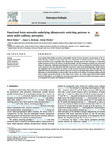Functional brain networks underlying idiosyncratic switching patterns in multi-stable auditory perception
| dc.contributor.author | Farkas, D | en |
| dc.contributor.author | Denham, SL | en |
| dc.contributor.author | Winkler, I | en |
| dc.date.accessioned | 2017-12-11T13:35:07Z | |
| dc.date.available | 2017-12-11T13:35:07Z | |
| dc.date.issued | 2018-01 | en |
| dc.identifier.issn | 0028-3932 | en |
| dc.identifier.uri | http://hdl.handle.net/10026.1/10402 | |
| dc.description.abstract |
In perceptual multi-stability, perception stochastically switches between alternative interpretations of the stimulus allowing examination of perceptual experience independent of stimulus parameters. Previous studies found that listeners show temporally stable idiosyncratic switching patterns when listening to a multi-stable auditory stimulus, such as in the auditory streaming paradigm. This inter-individual variability can be described along two dimensions, Exploration and Segregation. In the current study, we explored the functional brain networks associated with these dimensions and their constituents using electroencephalography. Results showed that Segregation and its constituents are related to brain networks operating in the theta EEG band, whereas Exploration and its constituents are related to networks in the lower and upper alpha and beta bands. Thus, the dimensions on which individuals' perception differ from each other in the auditory streaming paradigm probably reflect separate perceptual processes in the human brain. Further, the results suggest that networks mainly located in left auditory areas underlie the perception of integration, whereas perceiving the alternative patterns is accompanied by stronger interhemispheric connections. | en |
| dc.language.iso | en | en |
| dc.publisher | Elsevier | en |
| dc.subject | EEG | en |
| dc.subject | auditory streaming | en |
| dc.subject | functional networks | en |
| dc.subject | individual differences | en |
| dc.subject | minimum spanning tree | en |
| dc.subject | perceptual multi-stability | en |
| dc.title | Functional brain networks underlying idiosyncratic switching patterns in multi-stable auditory perception | en |
| dc.type | Journal Article | |
| plymouth.author-url | https://www.ncbi.nlm.nih.gov/pubmed/29197502 | en |
| plymouth.publication-status | Published online | en |
| plymouth.journal | Neuropsychologia | en |
| dc.identifier.doi | 10.1016/j.neuropsychologia.2017.11.032 | en |
| plymouth.organisational-group | /Plymouth | |
| plymouth.organisational-group | /Plymouth/REF 2021 Researchers by UoA | |
| plymouth.organisational-group | /Plymouth/REF 2021 Researchers by UoA/UoA04 Psychology, Psychiatry and Neuroscience | |
| plymouth.organisational-group | /Plymouth/Research Groups | |
| plymouth.organisational-group | /Plymouth/Research Groups/Centre for Brain, Cognition and Behaviour (CBCB) | |
| plymouth.organisational-group | /Plymouth/Research Groups/Centre for Brain, Cognition and Behaviour (CBCB)/Brain | |
| dcterms.dateAccepted | 2017-11-27 | en |
| dc.rights.embargodate | 2018-12-02 | en |
| dc.identifier.eissn | 1873-3514 | en |
| dc.rights.embargoperiod | Not known | en |
| rioxxterms.versionofrecord | 10.1016/j.neuropsychologia.2017.11.032 | en |
| rioxxterms.licenseref.uri | http://www.rioxx.net/licenses/all-rights-reserved | en |
| rioxxterms.licenseref.startdate | 2018-01 | en |
| rioxxterms.type | Journal Article/Review | en |


